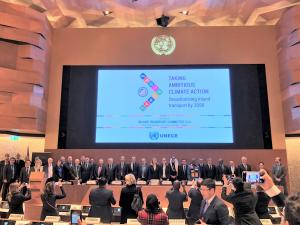UN member States took a decisive step towards sustainable low carbon mobility with the adoption on 23 February of the Inland Transport Committee’s (ITC) Strategy on Reducing Greenhouse Gas Emissions from Inland Transport.
Transport accounts for some 23% of annual GHG emissions. Inland transport accounts for 72% of this total, with 69% coming from road transport, 2% from inland shipping and 1% from rail. In addition, demand for passenger transport is projected to increase by 79% and freight transport by 100% by 2050. Since transport is such a large contributor to carbon emissions, rapid and ambitious climate action by the inland transport sector is imperative.
The strategy aims to transform the way inland transport is approached globally, and to set a medium- and long-term course towards carbon neutrality by 2050, based on the 61 United Nations legal instruments under ITC’s purview.
“What we do today will shape the future of transport,” said Mark Harbers, Minister of Infrastructure and Water Management of The Netherlands, at the opening of the 86th session of ITC. “We are here to take steps towards a future-proof inland transport system. One that takes account of climate-related challenges, energy security and road safety. It is also vital that the transition to clean transport is a just transition. So, I’m pleased that the ITC has taken the lead in developing quality standards for importing and exporting used vehicles”.
“Decarbonization of the transport sector is lagging behind many other sectors. This strategy will help countries to deliver on a significant part of their climate commitments under the Paris Agreement. Its adoption therefore marks a crucial milestone in climate action”, noted UNECE Executive Secretary Tatiana Molcean. “Decarbonization of mobility will require a shift to electrification and the prioritization of public transport and active mobility options but also significant societal changes. Each country will have to adopt the relevant fiscal incentives and policy mechanisms needed for its population to embrace this transition”.
Objectives of the strategy
The main objective of the strategy is for ITC to take urgent action to assist its member States and Contracting Parties to United Nations legal instruments under its purview in achieving the aspirational goal of net zero GHG emissions from inland transport by 2050 .
The strategy gives priority to public transport in combination with cycling and walking for passenger transport and enables new approaches to urban freight solutions, as well as improving vehicles, infrastructure and operations, including border crossing operations, to make the inland transport sector more efficient.
The strategy aims to achieve this through improved regulatory support, intergovernmental policy dialogue, and enhanced coordination and partnership between all relevant governments and stakeholders.
Specific strategic objectives of the strategy for the inland transport sector include:
-
Developing and enhancing decarbonization policies, legislation and measures, including their monitoring;
-
Fostering the efficient use of energy and optimized driving behaviour, and the use of Intelligent Transport Systems (ITS) and digitalization;
-
Accelerated substitution of fossil-fuelled vehicles with zero emission vehicles, and the efficient use of transport networks, movement of people and freight;
-
Promoting research and development of carbon-neutral energy technology and fuels, such as hydrogen;
-
Supporting circular economy related practices and determining the carbon footprint of all types of transport vehicles and transportation infrastructure through life-cycle analysis;
-
Replacing parts and retrofitting to extend the lifetime of automotive products; and promoting the use of sustainable fuels and ensuring effective recycling, e.g. of batteries.
Implementation
The strategy will be implemented through an initial ITC Climate Action Plan with milestones, which will guide ITC to help member States and Contracting Parties to deliver climate goals and priorities, such as developing a globally harmonized methodology to determine the carbon footprint of vehicles from cradle-to-grave by 2025, and elaborating policy solutions for Mobility as a Service (MaaS) for passenger movement by 2030.
In doing so, the ITC draws from a broad decarbonization framework that draws on avoid-shift-improve measures which Member States may implement in any of or across the following areas:
-
Avoid unnecessary vehicle kilometers through compact development, increasing accessibility to services, and reducing the need to travel as much as we do today.
-
Shift to low and zero carbon, sustainable transport modes and/or operations; and
-
Improve vehicles, infrastructure, and operations.
ITC will adjust and include additional actions during the plan’s biennial review based on proposals made by its subsidiary bodies. The strategy will be subject to a five-yearly review, with the first review due in 2029. ITC will centrally coordinate the review, including defining its scope and terms of reference.
Role of UN inland transport instruments
Many of the 61 UN inland transport legal instruments under the purview of ITC already support or have the potential to improve the sustainability of transport and tackle climate change on a number of fronts.
For example, the European Agreement on Main International Railway Lines (AGC), or the European Agreement on Main Inland Waterways of International Importance (AGN), provide the prerequisites for the necessary infrastructure to enable the modal shift from road to rail and inland waterways.
The European Agreement on Important International Combined Transport Lines and Related Installations (AGTC) promotes multimodal transport to alleviate the burden on the European road network and mitigate environmental damages. The Model Rules on the Permanent Identification of Railway Rolling Stock aim at facilitating investment in railway rolling stock to increase the shift from road to rail.
Likewise, UN regulations already enable harmonized measurement of vehicles fuel consumption and tailpipe CO2 emissions and the widespread introduction of alternative fuel sources, including electric, hybrid and hydrogen.
UNECE is also developing a globally harmonized methodology to determine vehicles’ carbon footprint throughout their life cycle, and is working to regulate the climate impact of some 23 million used vehicles, which were exported in 2015-2020, around 66% of which to developing and transitional countries.


